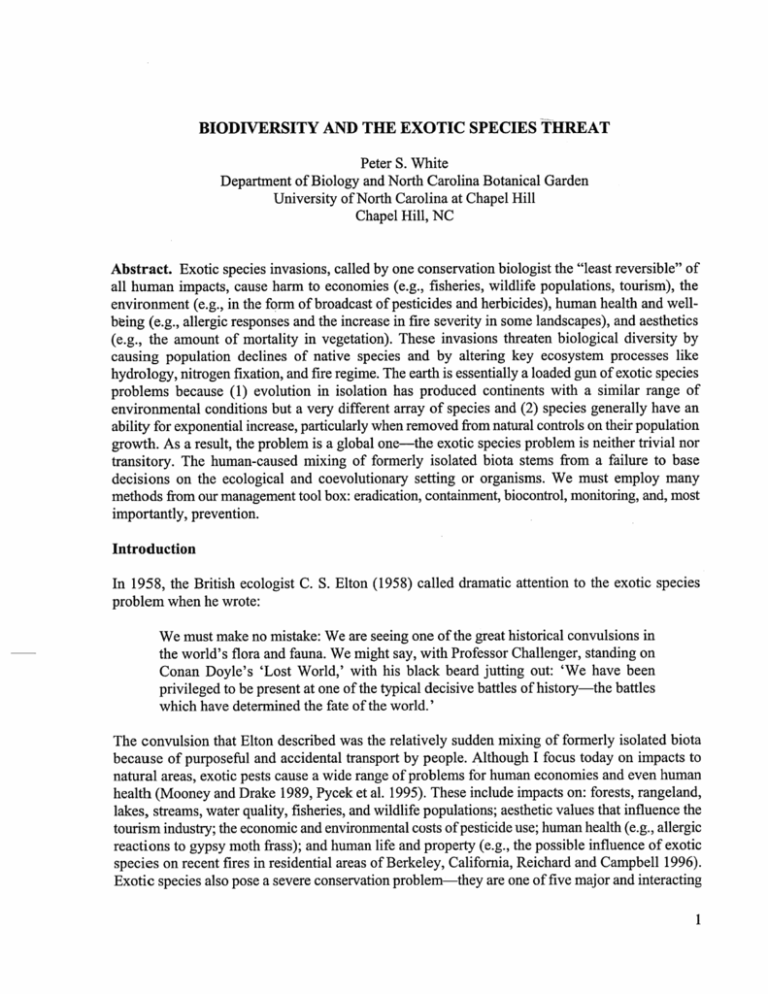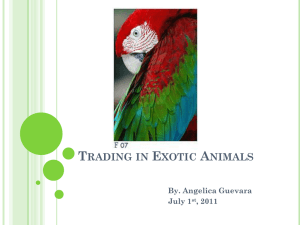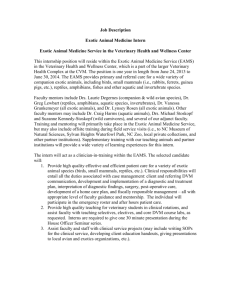Biodiversity and the exotic species threat
advertisement

BIODIVERSITY AND THE EXOTIC SPECIES THREAT Peter S. White and North Carolina Botanical Garden Biology of Department University ofNorth Carolina at Chapel Hill Chapel Hill, NC Abstract. Exotic species invasions, called by one conservation biologist the "least reversible" of all human impacts, cause harm to economies (e.g., fisheries, wildlife populations, tourism), the environment (e.g., in the form of broadcast of pesticides and herbicides), human health and wellbeing (e.g., allergic responses and the increase in fire severity in some landscapes), and aesthetics (e.g., the amount of mortality in vegetation). These invasions threaten biological diversity by causing population declines of native species and by altering key ecosystem processes like hydrology, nitrogen fixation, and fire regime. The earth is essentially a loaded gun of exotic species problems because (1) evolution in isolation has produced continents with a similar range of environmental conditions but a very different array of species and (2) species generally have an ability for exponential increase, particularly when removed from natural controls on their population growth. As a result, the problem is a global one-the exotic species problem is neither trivial nor transitory. The human-caused mixing of formerly isolated biota stems from a failure to base decisions on the ecological and coevolutionary setting or organisms. We must employ many methods from our management tool box: eradication, containment, biocontrol, monitoring, and, most importantly, prevention. Introduction In 1958, the British ecologist C. S. Elton (1958) called dramatic attention to the exotic species problem when he wrote: We must make no mistake: We are seeing one of the great historical convulsions in the world's flora and fauna. We might say, with Professor Challenger, standing on Conan Doyle's 'Lost World,' with his black beard jutting out: 'We have been privileged to be present at one of the typical decisive battles of history-the battles which have determined the fate of the world.' The convulsion that Elton described was the relatively sudden mixing of formerly isolated biota because of purposeful and accidental transport by people. Although I focus today on impacts to natural areas, exotic pests cause a wide range of problems for human economies and even human health (Mooney and Drake 1989, Pycek et al. 1995). These include impacts on: forests, rangeland, lakes, streams, water quality, fisheries, and wildlife populations; aesthetic values that influence the tourism industry; the economic and environmental costs of pesticide use; human health (e.g., allergic reactions to gypsy moth frass); and human life and property (e.g., the possible influence of exotic species on recent fires in residential areas of Berkeley, California, Reichard and Campbell 1996). Exotic species also pose a severe conservation problem-they are one of five major and interacting 1 threats to biological diversity. The other four are: habitat loss and fragmentation, chemical and physical alteration of environment, change in natural process (e.g., hydrology and fire regime), and direct harvest of individual species. Exotics threaten natural areas by reducing or eliminating populations of native species and by altering key ecosystem processes (Vitousek 1990). Devine (1994) suggested that more habitat was lost in South Florida each year to exotics than to development. Coblentz (1990), noting the difficulty of eliminating established populations, called the exotic species problem the least reversible of all human impacts. / In this paper, I will present a general context for the exotic species problem, showing that the earth is a loaded gun of potential exotic species problems--the problem is neither trivial nor transitory. I define the range of impacts caused by exotic plants and suggest policy, research, and management issues that we must face. The evolutionary backdrop to exotic species problems: evolution in isolation, exponential increase, and coevolution Two observations figured prominently in the thinking of Charles Darwin as he sought an explanation for life's diversity: First, places that have similar climates but have been long isolated from each other, have different biota and, second, all species have the ability for exponential increase in population numbers given the right circumstances. As naturalist on the Beagle, Darwin puzzled over the fact that two deserts with similar soils, temperature regime, and precipitation, would have entirely different plants and animals: In considering the distribution of organic beings over the face of the globe, the first great fact which strikes us is, that neither the similarity nor the dissimilarity of the inhabitants of various regions can be wholly accounted for by climatal and other physical conditions .... There is hardly a climate or condition in the Old World which cannot be paralleled in the New ... [yet] how widely different their organic productions [i.e., their species]! A second great fact which strikes us in our general review is, that barriers of any kind, or obstacles to free migration, are related in a close a11d important manner to differences between productions of various regions. Interruptions to gene flow, combined with founder affects and historical isolation of lineages, produces this pattern. Continental and other separations are a mechanism that increases the biological diversity of the earth. Preston (1962) published figures that showed that the total number of birds on the planet was at least four times higher than you would predict from the species-area relation for each separate continent. In other words, if you extrapolated from the data for a single continent to an area equivalent to the summed terrestrial habitat of the earth, you would predict a species total only 25% the observed total. Continental isolation is indeed a potent generato~ of species diversity. All those additional species on a separate continent, however, become the potential invaders of today's world. For any given climate, there is a place somewhere on another continent with a similar environment that harbors organisms that are potential exotic invaders. For eastern North America, the biggest source area is the humid temperate lands of the other major North Temperate continent: 2 east Asia. Since east Asia suffered fewer extinctions during the Pleistocene than eastern North America, the potential list of invaders from that area is very high. An added problem is that east Asian and eastern North American have species descended, in part, from the same ancestors, thus creating an added problem: the chance for hybridization between closely related Asian and American taxa and the exchange of pathogens that are adapted to particular genera or even sections within a genus that are found in the two areas. I return to this subject below when I discuss the coevolutionary paradigm. Ecologist Gordian Orians coined the term "Homogecene" for the modem era in which humans are tending to homogenize the world's flora and fauna through transport across once insurmountable barriers. Much of the transport is purposeful: Reichard and Campbell (1996) reported that, of235 invasive woody plants in North America, 85% were introduced for ornament and landscape purposes. Other introductions have been made for reducing soil erosion or supporting wildlife populations. While many have written that introductions are accidental, Cairns and Bidwell ( 1996) noted that "careless" was a better description than "accidental." Elton (1958) noted that the isolation ofbiota, at least in terms of higher taxonomic levels, was not constant through the geological record (we would later find the explanation in continental drift and changing climates): .. .in the very early times, say 100. million years ago in the Cretaceous Period, the world's fauna was much more truly cosmopolitan, not so much separated off by oceans, deserts, and mountains. If there had been a Cretaceous child living at the time ... he would have read ... 'Very large dinosaurs occur all over the world except in New Zealand' ... There would have been n1uch less use for zoos. By implication, if the world's flora was more homogeneously distributed across the continents, there would be little need for botanical gardens to display odd, unusual, or unknown species. Darwin's second observation was that all species "overproduced" young-that is, they all had a potential for exponential increase: There is no exception to the rule that every organic being naturally increases at so high a rate, that, if not destroyed, the earth would soon be covered by the progeny of a single pair... The elephant is reckoned the slowest breeder of all known animals ... [yet] after a period of from 740 to 750 years there would be nearly nineteen million elephants alive, descended from the first pair. The reason that elephants don't cover the surface of the earth is that the environment poses limits to population growth. Some of those limits are biological: species face natural enemies that increase their mortality rates and decrease their growth and reproductive rates. Thus, one explanation for the success of exotic species is that they have an advantage: they have a lower natural enemy load in a new land. Imura and Carstensen ( 1993) found that enemy loads of kudzu on its home range in Japan were more than twice the level found in the southeastern United States and that the enemies included more kudzu-specific herbivores. The consequence of this argument has a troubling 3 dimension: species likely to invade may not be predictable from their biological traits if the explanation lies in their biological environment. The power of natural enemies is, of course, seen in the cases of successful biocontrol, like the importation of the South American cactoblastus moth to control the introduced opuntia in Australia (Dodd 1940). In fact, one of the paradoxes of plant introduction is that horticulturists look for plants that are relatively pest-free and, if they obey quarantine regulations, plants are released purposefully without natural enemies. The introduced plant may acquire new enemies-but they will often be generalists rather than specialists. If the introduced plant becomes a pest species, we then must go exploring for biocontrol agents. While the ideal biocontrol agent is highly specific to the problem species, there is a danger, of course, that it will affect native species as well. Like genetic hybridization, this is a special danger for closely related plants: the biocontrol agent is preadapted to the native species, which, in turn, may have no evolved resistance to that control agent. Chestnut blight, an Asian fungus, is a much more effective "control" agent on American chestnut than on the species with which it evolved, Chinese chestnut. Species native in North America that are in the same genus as the Asian chestnut blight did not impact the American chestnut to the degree that the exotic disease did. From these thoughts we can develop a "coevolution" paradigm. Namely, the biological attributes of a species evolved within a biological setting. If species achieved stability in the presence of their enemies, it was through coevolution: the rapid demise of the host is not advantageous to either host or pest, so hosts evolve sorne resistance and pests evolve a lowered virulence. Descent from common ancestors contributes to the problem: pest species will be preadapted to invade the related plant, but there will be no coevolved stability. In summary, evolution in isolation, exponential increase, coevolution, and descent from common ancestors (causing the special problem of congenerics for hybridization and disease and pathogen spread), have an important consequence: we live in a world that is a loaded gun for exotic species problems. We transport species freely across barriers because we forget that the ecological and coevolutionary setting of plants is a key to their identity, population traits, and ability to invade. Impacts of exotic plants Impacts of exotic plants range across a wide spectrum (Table 1 from White, in press). Some introduced plants are, in fact, hard to cultivate in particular climatic settings. Others persist after cultivation, but, so far, have not become invaders of natural areas. Others spread vegetatively, but not by seed. Some spread by seed, but only into human created habitats like roadsides. A subset of the species successfully invade natural areas where they may reduce or eliminate native populations and even change the way ecosystems function (e.g., effects on hydrology, fire regime, and nitrogen cycling). Williams and Fitter (1996) proposed the rule of lOs: that one in 10 introductions persists, one in 10 of those invade, and one in 10 of those becomes a pest. Thus, one in 1,000 introductions becomes a problem. However, there are several caveats to this argument. While not all introductions become 4 pests, those that do are extremely expensive to combat. Also, Williamson and Fitter (1996) show that the data support quite a bit of variation-the one in 10 rule really means one in 5 to one in 20. A final, and perhaps most serious, caveat is that species evolve: what appears to be a non-invasive introduction now, could become one later. Species that are released from natural enemies might evolve towards higher growth and reproductive rates for that very reason if there is a trade-off between growth rate and pest resistance. Faster growing, but less defended, genotypes might succeed in environments were pest resistance is not required. If its planting density is low and cross pollination limited or if a pollinator is lacking, the selfing genotype will increase through time. Perhaps a species that appears noninvasive will acquire a pollinator or a seed disperser. Perhaps it appears to be a noninvader in bad years and unfavorable places, only to become invasive in other years and in other places. In short, the very trait we are worried about, invasiveness, may itself be variable in space and time. The experiment is not over-many introduced species have not yet had time to prove their invasiveness and we may never be one hundred percent certain that a species is noninvasive. This argues for caution and care. The conservation response The exotic pest plant issue will require a diverse tool box of conservation strategies. Because of the difficulty of controlling established exotics, one of the most important strategies is to reduce the number of potential new exotics. Prevention is worth a pound of cure. I have argued elsewhere (White, in press, 1996) that two policies on introdic.tions need to be pursued: ( 1) risk assessment, combined with early detection and eradication ahd (2) use of native species for ornament, landscaping problems, and other uses. Risk assessment hinges on our ability to predict invasiveness. Many important research questions remain, and even the most successful risk assessment will require a method for early detection of new invasions (for those species that are introduced accidentally and for those that are not identified as invasive by the screening criteria). Reichard (Reichard and Campbell 1996) has developed screening criteria for potential woody plant introductions that would be a tremendous improvement over the current lack of assessment and regulation. Her data· suggest that it may be possible to screen out over 90 percent of pest woody species that are introduced purposefully by botanical gardens and nurseries. In addition to prevention (including preclearance, exclusion, and detection of infestations), containment, eradication, and biological control are all important an necessary strategies (Westbrooks and Eplee 1996). We will have to have an integrated pest management approach in which restoration of natural processes and native vegetation will play a role. We will have to use an adaptive management paradigm, in which new information from monitoring and evaluation is used to improve our management programs. Because this is a global problem, with North American exports posing just as much a threat as imports from the rest of the wodd, international communication and cooperation will be required. Since invasiveness on one continent helps predict invasiveness on another (Reichard and Campbell 1996), international coordination is essential. We need an international clearinghouse and register of information on invasive exotics. 5 LITERATURE CITED Cairns, J., Jr., and J. R. Bidwell. 1996. Discontinuities in technological and natural systems caused by exotic species. Biodiversity and Conservation 5:1085-1094. Coblentz, B. E. 1990. Exotic organisms: a dilemma for conservation biology. Conserv. Bioi. 4:261-265. Devine, R. 1994. Botanical barbarians. Sierra January-February issue, 1994:50-71. Dodd, A. P. 1940. The biological campaign against prickly pear. Commonwealth Prickly Pear Board. Government Printer, Brisbane, Australia. Elton, C. S. 1958. The ecology of invasions by plants and animals. Chapman and Hall. New York. 181 p. Imura, 0., and S. Carstensen 1993. Herbivory of kudzu (Pueraria lobata) in origin and introduced region. XV International Botanical Congress, Yokohama, Japan, page 289. Mooney, H. A., and J. A. Drake (eds.) 1986. Ecology ofbiological invasions ofNorth America and Hawaii. Ecologic.al Studies 58. Springer-Verlag. New York. Preston, F. E. 1962. The canonical distribution of commonness and rarity: parts I and II. Ecology 43, 185-215; 410-432. Pycek, P., K. Prach, M. Rejmanek, and M. Wade (eds.). 1995. Plant invasions: general aspects and special problems. Amsterdam: SPB Academic. Reichard, S., and F. Campbell. 1996. Invited but unwanted. American Nurseryman (July):39-45. Vitousek, P. M. 1990. Biological invasions and ecosystem processes: towards an integration of population biology and ecosystem studies. Oikos 57:7-13. Westbrooks, R. G., and R. E. Eplee. 1996. Regulatory exclusion ofharmful non-indigenous plants from the United States by USDA APHIS PPQ. Castanea 61:305-312, White, P. S. 1997. · In press. A bill falls due: botanical gardens and the exotic species problem. The Public Garden. White, P. S. 1996. In search of the conservation garden. The Public Garden 11(2):11-13,40. Williamson, M., and A. Fitter. 1996. The varying success of invaders. Ecology 77:1661-1666. 6 Table 1. The range of exotic plant impacts to biological diversity (from White, in press). Degree of exotic plant impacts on biological diversity Species that do riot persist after cultivation; dependent on cultivation Species that persist after cultivation but do not spread Species that spread locally after cultivation by vegetative means, but not by seed Species that spread locally after cultivation by seed or seed and vegetative means Species that spread only in human-created habitats: roadsides, lawns, fields Species that spread into native habitats, but do not reduce native species Species that spread into native habitats, reduce or eliminate native species Species that spread into native habitats, change ecosystem function, alter, composition, and reduce or eliminate native species Table 2. Traits of successful invaders.. Traits: Environmentally fit Rapid growth Early maturity (flowering) Prolific seed production Highly successful dispersal (germination, establishment) Rampant vegetative spread No major pests Caveats against superficial evaluation: Performance is a function of environment and soil Reproductive performance can be a function of density and the presence of compatible genotypes, dispersers Many traits can be genetically variable and can evolve Natural selection for genotypes with highest reproductive output Evolution of selfing from outcrossers The biological environment can vary: pollinators, dispersers, and enemies are not constant Establishment can vary with disturbance and the nature of the ecosystem invaded 7






